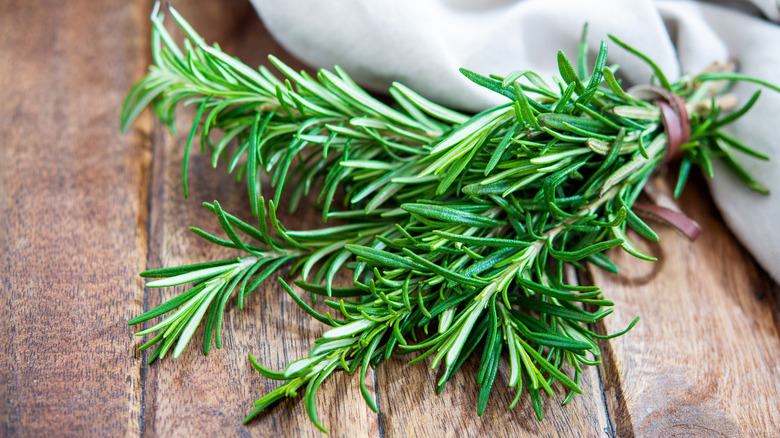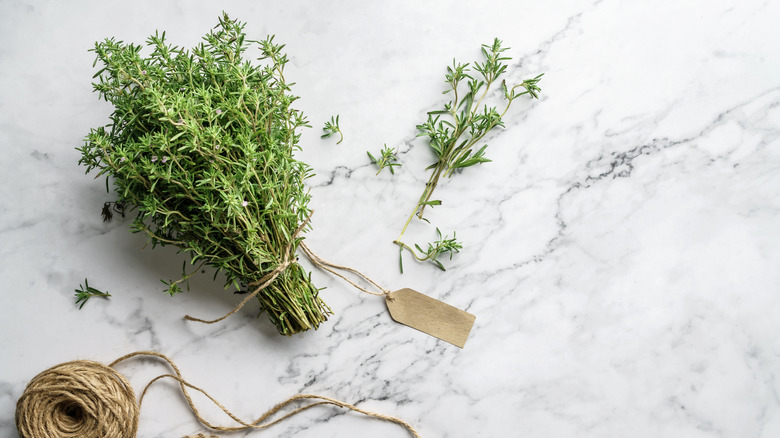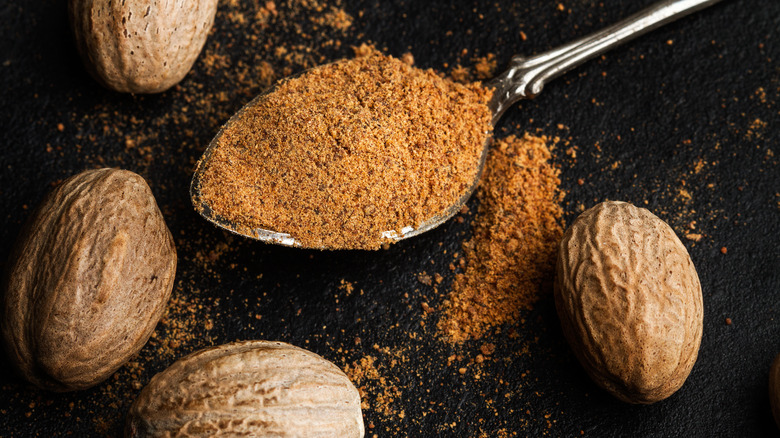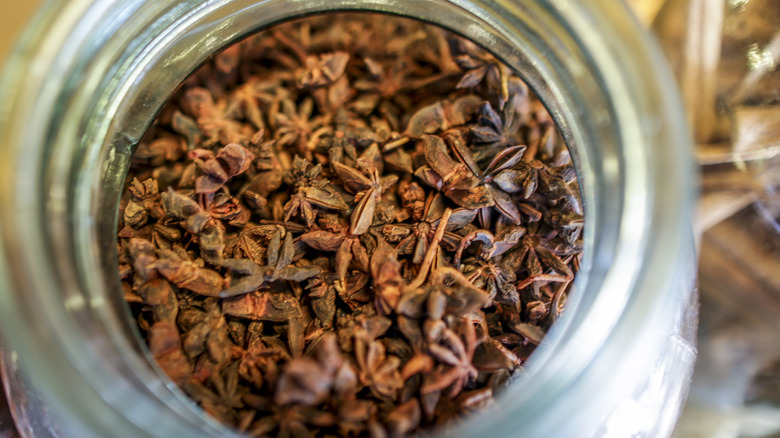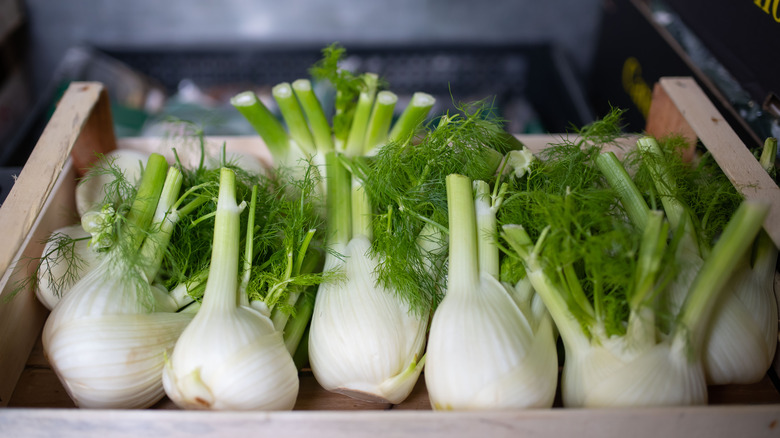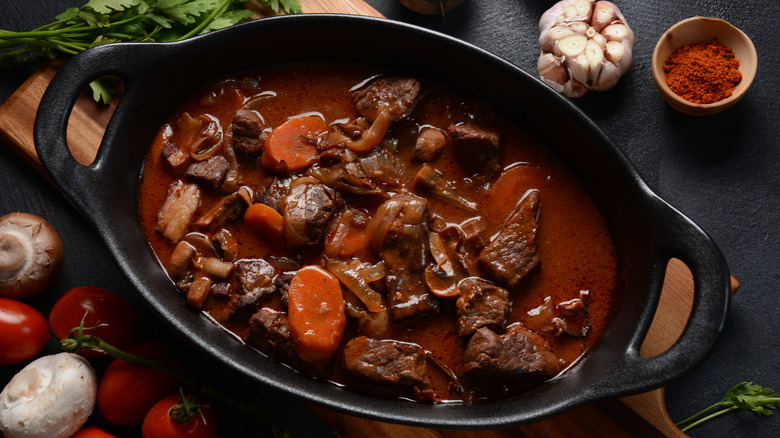7 Ingredients You Should Never Pair With Cilantro
Also known, as Chinese parsley, Mexican parsley, or simply, fresh coriander leaves, cilantro is the leaf of the coriander plant. This popular (yet extremely polarizing) herb is often found pulverized in salsa or chopped and sprinkled fresh over a variety of international cuisines. It is cooling and bright and offers pungent citrus and peppery qualities.
A favorite of backyard gardeners, cilantro can be grown from seed, and is best consumed before the plant bolts, or goes to flower, according to Utah State University. It's easy to find in grocery stores and farmers markets and is ideally served fresh after a wash. Many recipes call for cilantro, particularly those with lime, jalapeno, mint, garlic, and parsley. Though it may be a welcome addition to street tacos or an Asian stir fry, that doesn't mean this kitchen staple goes well with everything. Here are ingredients that you should never pair with cilantro.
Rosemary
The resinous, piquant notes of rosemary are often used in deeply savory dishes such as flatbread, roasted poultry, slow-cooked meats, substantial stews, and mashed potatoes. A component of herbes de Provence, rosemary offers pine and wood notes which oppose the tender brightness of cilantro, which is why the two aren't likely to be called for together. Because the power of rosemary can be overwhelming, it is recommended to chop this herb finely, or use whole sprigs that can be removed before serving. But people love rosemary for many reasons that extend beyond the kitchen, and it's been called the ultimate multi-tasker, a perennial favorite in family gardens.
For generations, rosemary has been employed as a medicinal and aromatherapy treatment to improve concentration and circulation and to relieve stress, according to Medical News Today. There is also evidence that it repels unwanted insects such as flies and mosquitoes and attracts beneficial buzzers such as bees (via Country Living).
Thyme
Thyme announces itself with a grassy, woody character in a depth that clashes with cilantro. According to Iowa State University, these two herbs may grow together in the home garden, but they are rarely called upon to enhance a common dish. While cilantro is an ideal fit for summer poultry (this ancho-grilled chicken breast recipe, for example), thyme is better suited for winter fare such as a Thanksgiving turkey. It is also compatible with ribeye steaks, roasted potato dishes, holiday stuffing, savory cocktails, and even some desserts.
This spice rack staple can be consumed dried, but many people prefer thyme when it is fresh. The small, delicate leaves can easily be stripped from the stems and sprinkled whole into the dish. According to Gardening Know How, there are hundreds of species of thyme, and the various types have unique features that go beyond the kitchen such as fragrant components of lotions, candles, and sachets.
Nutmeg
Nutmeg is warm spice that is often finely ground, and the namesake nuttiness can offer a pleasant sweetness but also bitter notes, if too much is used (via Spiceography). According to Britannica, the seed is harvested from a tree native to the Indonesian islands, which is also the source for a spice called mace. Healthline advises that nutmeg should be consumed in small quantities of less than two teaspoons, because it contains a natural compound that impacts the central nervous system. While some people might say this is intoxicating, it is more fitting to say that too much is poisonous. Dizziness and confusion are some of the symptoms that result from consuming too much nutmeg, but when employed in reasonable amounts, benefits include antioxidant and anti-inflammatory qualities.
A featured component in pumpkin spice, nutmeg is a popular addition to autumnal baked goods, eggnog, chai tea, mulled wine, and curry blends. Since its well-suited for cool weather recipes, it's no surprise that nutmeg's flavor profile lies in sharp contrast with the bright peppery notes of cilantro.
Anise
There are two products in the anise realm: anise seed and star anise. According to Garden Know How, these can be used similarly in cooking, but they aren't of the same origins. Anise is typically used as a ground spice, while star anise is used in pod form — similar to ground cinnamon versus a cinnamon stick. Anise adds complexity to baked goods like cookies and biscotti, and it also famously flavors digestive liqueurs called anisettes which include Sambuca from Italy and Ouzo from Greece. There's also an interesting American version of Ouzo that includes both anise and star anise.
Anise falls into a category with cinnamon, cloves, nutmeg, and allspice and these kitchen spice notes clash with the fresh zip of cilantro. Pungent and polarizing, this ingredient reminds many people of black licorice. The citrus brightness of cilantro is also pungent and polarizing, because for some people with a certain genetic makeup, it can taste like soap or dirt (via Flavour). Even major food figures like Ina Garten hate cilantro. According to an essay in Epicurious, anise earns equal scorn from some tasters, and bringing the two divisive ingredients together will only make matters worse.
Fennel
A flowering perennial herb that's also considered a vegetable, fennel also leans into the black licorice profile. It has a round, bulbous shape with fragrant and delicate fronds. Fennel can be used fresh or raw to bring out the most pronounced flavors or it can be cooked to settle into more subtle notes. It is often enjoyed thinly sliced in a salad or as a part of soup, stir fry, or stews. The seeds of the fennel plant have both culinary and medicinal uses, according to WebMD, and they are sometimes marketed as a weight loss aid.
Interestingly enough, both fennel and cilantro have related origins as members of the parsley family. The entire fennel plant is edible, making it a versatile ingredient, but not versatile enough to marry with cilantro. Combined, these two bold herbs would create flavor chaos.
Coffee
Cilantro is no stranger to hot drinks — the leaves and seeds are commonly used in teas. According to Wellness Mama, the seeds are regarded as a digestive aid with the ability to relive anxiety. But that's not to say that it's suitable for any warm mug. According to Insider, a variety of unexpected ingredients can spice up coffee, including cinnamon, cardamom, and salt; but the tangy notes of cilantro just don't fit in here. The herb would simply be overpowered by the roasted notes of the beans.
Interestingly, there are some similar benefits that both coffee and cilantro share. According to Ayurvedic practitioner Annette Shellenbarger of Chandra Ayurveda, they are both anti-inflammatory and antimicrobial. They also protect the liver. For those looking to sip their cilantro, an icy or chilled drink is a better fit. Try a frothy margarita, a refreshing gin and tonic, or this tomatillo and tequila cocktail recipe which is garnished with a few sprigs of the leafy herb.
Red wine
Cilantro isn't the right ingredient for recipes that rely on tannic red wines. Tannins are compounds found in plants that make them taste bitter or feel astringent. According to Wine Enthusiast, this is an evolutionary technique to prevent animals from eating seeds before their prime. Red wines get both color and tannic elements from their skins, seeds, and stems if left in contact with them during vinification.
These tannins can also impart flavor into sauces, stews, and other dishes that call for red wine. Tannins contribute valued structure and depth, but this isn't a profile that goes well with the zesty frame of cilantro. While the flavor of fresh cilantro can be bold and boisterous, this spice loses its vitality when overcooked, according to SPICEography. Dishes that incorporate red wine such as stews and sauces often spend time bubbling and simmering over heat, and this technique will drain cilantro of most of its flavor.

